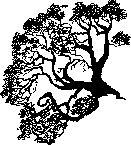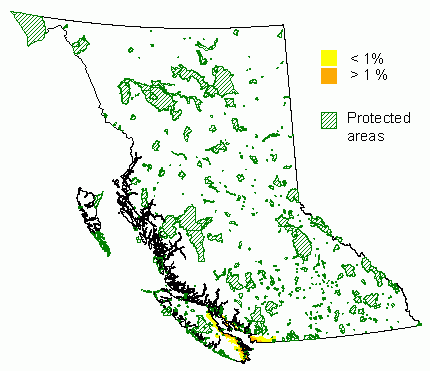 Arbutus
Arbutus
Arbutus menziesii Pursh
Introduction
Arbutus grows as a tall shrub or small to medium-sized, tree. This evergreen broadleaf grows in small, open stands, or mixed with Douglas-fir or lodgepole pine. Typically, it grows on rocky shores or outcrops with a warm aspect. It is frequent on dry and poor soils. Arbutus often grows in early-successional habitat, but is present in all stages of secondary succession and old growth. Frost and fire are major potential damaging agents. Arbutus has a variety of diseases (Burns and Honkala 1990). Three pathogens are most likely to cause death: root rot (Phytophthora cactorum), Arbutus canker (Natrassia mangiferae) and madrone canker (Fusicoccum aesculi) (Byther 1999; Elliott 1999a; Elliott 1999b). Changing environmental conditions may encourage outbreaks of disease. Urban development exposes trees previously growing in the forest, which results in increased susceptibility to disease and decline (Bressette and Hamilton 1999). In British Columbia, man-made root disturbance may predispose trees to attack by the native fungus Natrassia mangiferae, which causes canker and dieback (Hunt 1999). Mycorrhizas may play a role in the resistance of some trees to decline (Trudell et al. 1999). Phytophthora ramorum, a new pathogen of unknown origin causing “sudden oak death” in California and Oregon, can also damage arbutus, causing leaf spots and cankers. Since this pathogen is thought to spread rapidly on ornamental plants like rhododendron (DeFrancesco, 2001), especially in wet weather, it may become important for British Columbia in the future.
The species reaches the northern limits of its range in southwestern British Columbia and on Vancouver Island. The major part of its native range is outside of British Columbia: the central and southern Pacific region, and some (small) areas in the central and southern Cordilleran region. Its range in British Columbia is very limited (Little 1971).
Distribution and Protected Areas – from Hamann et.al. 2005



Conservation Status Summary – from Chourmouzis et.al. 2009
“The northern edge of the range of Arbutus extends into the CDF and CWH zones in southern British Columbia. Based on the calculated occurrence levels, it is recommended that the occurrence of this species in protected areas in the CDF zone be verified. Given that Arbutus has been observed in many smaller protected areas (e.g., Spectacle Lake, Mount Tzouhalem Ecological Reserve, Mount Maxwell Park and Reserve, Woodley Range Ecological Reserve, Ladysmith Bog Ecological Reserve, Arbutus Grove, Boyle Point), in numerous regional parks around southeastern Vancouver Island, and on Crown and private land that is not viable for forestry, it is likely that actual protection levels for this species are adequate. A comprehensive re-evaluation of protection status of all species in the CDF zone should be conducted prior to any field verification efforts. Verification, and if required, increased protection, are also recommended in the CWH zone, where this species has the potential to increase with climate warming.”
Reproduction
Although arbutus reproduces mainly by sprouting, the species produces fruit abundantly almost every year (Roy 1974; Banerjee et al. 2001). The berries fall on the ground and are spread by birds and rodents. However, in general, seedlings of arbutus are not abundant. They may die of drought, damping off, and damage by invertebrates (Tappeiner et al. 1986). The best seedbed is bare mineral soil. Arbutus seems to have difficulty regenerating under its own canopy. This might be due to the presence of toxic metabolites in the leaves, a finding which Tinnin and Kirkpatrick (1985) investigated and confirmed in the lab but could not confirm in the field.
Genetic structure
No information available.
Resource management and seed transfer
No information available.
REFERENCES
Hamann, A., Smets, P., Aitken, S. N. and Yanchuk, A. D. 2005. An ecogeographic framework for in situ conservation of forest trees in British Columbia. Can. J. For. Res. 35:2553-2561. View online resources for this report.
C. Chourmouzis, A.D. Yanchuk, A. Hamann, P. Smets, and S.N. Aitken. 2009. Forest Tree Genetic Conservation Status Report 1: In situ conservation status of all indigenous BC species. Centre for Forest Conservation Genetics, Forest Genetics Council of BC, and BC Ministry of Forests and Range, Forest Science Program, Victoria, BC Technical Report 053. www.for.gov.bc.ca/hfd/pubs/Docs/Tr/Tr053.htm
Banerjee, S. M., Creasy, K. and Gertzen, D. D. 2001. Native woody plant seed collection guide for British Columbia. Crown Publications, Victoria. 147 p.
Bressette, D. K. and Hamilton, C. W. 1999. Determining causes of Pacific madrone decline in urban landscapes of the Pacific Northwest. In: A. B. Adams and C. W. Hamilton (Eds.), The decline of Pacific madrone (Arbutus menziesii Pursh) : current theory and research directions. Proceedings of the April 28, 1995 Symposium held at the Center for Urban Horticulture, University of Washington, 146 p.
Burns, R. M. and Honkala, B. H. 1990. Silvics of North America vol.2: Hardwoods. Agriculture handbook 654. U.S. Dept. of Agriculture Forest Service, Washington, D.C. 877 p.
Byther, R. S. 1999. Some observations of madrone diseases. In: A. B. Adams and C. W. Hamilton (Eds.), The decline of Pacific madrone (Arbutus menziesii Pursh) : current theory and research directions. Proceedings of the April 28, 1995 Symposium held at the Center for Urban Horticulture, University of Washington, 146 p.
DeFrancesco, L. 2001. Sudden oak death linked to rhododendrons. Scientist 15:16-16.
Elliott, M. 1999a. The decline of Pacific madrone (Arbutus menziesii Pursh) in urban and natural environments: its causes and management. (M.S.) thesis. College of Forest Resources University of Washington, 154 p.
Elliott, M. 1999b. Diseases of Pacific madrone. In: A. B. Adams and C. W. Hamilton (Eds.), The decline of Pacific madrone (Arbutus menziesii Pursh): current theory and research directions. Proceedings of the April 28, 1995 Symposium held at the Center for Urban Horticulture, University of Washington, 146 p.
Hunt, R. S. 1999. Madrone problems in British Columbia. In: A. B. Adams and C. W. Hamilton (Ed.), The decline of Pacific madrone (Arbutus menziesii Pursh): current theory and research directions. Proceedings of the April 28, 1995 Symposium held at the Center for Urban Horticulture, University of Washington, 146 p.
Little, E., L., Jr. 1971. Atlas of United States trees, volume 1: Conifers and important hardwoods. U.S. Department of Agriculture. 9 p, 313 maps, Washington, DC.
Roy, D. F. 1974. Arbutus menziesii Pursh, Pacific madrone. p. 226-227 in: C. S. Schopmeyer (Ed.), Seeds of woody plants in the United States. Agriculture Handbook 450. U.S. Department of Agriculture, Washington, DC.
Tappeiner, J. C. I., McDonald, P. M. and Hughes, T. F. 1986. Survival of tanoak (Lithocarpus densiflorus) and Pacific madrone (Arbutus menziesii) seedlings in forests of southwestern Oregon. New Forests 1:43-55.
Tinnin, R. O. and Kirkpatrick, L. A. 1985. The allelopathic influence of broadleaf trees and shrubs on seedlings of Douglas-fir. Forest Science 31:945-952.
Trudell, S., Cline, E. T., Elliott, M. and Edmonds, R. L. 1999. Possible role of mycorrhizas in resistance to decline in Arbutus menziesii. In: A. B. Adams and C. W. Hamilton (Eds.), The decline of Pacific madrone (Arbutus menziesii Pursh) : current theory and research directions. Proceedings of the April 28, 1995 Symposium held at the Center for Urban Horticulture, University of Washington, 146 p.
